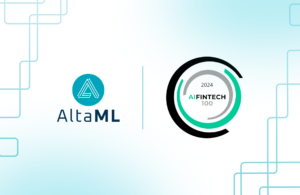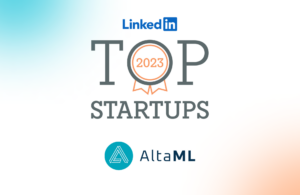The Power of Human Judgment: Why AI Still Requires Critical Thinking
July 5, 2023
•
4 min read
One of the most popular debates surrounding artificial intelligence (AI) and its widespread introduction in the workplace is the idea that AI will, well, replace us.
A common misconception is that AI deployment implies the exclusion of humans from the process, but this is not the case in most situations. In reality, people still play an essential role in reviewing AI outputs and making critical decisions on how to use them to inform long-term business decisions.
This brings us to the concept of human-in-the-loop (HITL), what it means and how it works.
Human-in-the-Loop
The theory of HITL aims to achieve what neither a human or machine can achieve on their own. When a machine can’t solve a problem, humans are often needed to step in and intervene. This process results in the creation of a continuous feedback loop. With constant feedback, the algorithm learns and produces better results, but relies on human judgment to ensure accuracy and relevance.
An example of this would be validating the outputs, scoring them, and tuning them up or down whenever the algorithm lacks confidence about a judgment or is too confident about an incorrect decision, humans can jump in and refine the response.
Human-in-the-Loop Vs. Full Automation
Humans need to perform three crucial roles. They must train machines to perform certain tasks; explain the outcomes of those tasks and sustain the responsible use of machines. So while automation reduces overhead costs, and conserves valuable resources tied to repetitive duties, it’s not always optimal. No intelligent system can truly predict all the feasible scenarios it may encounter in the real world, at least not yet.
AI solutions that operate entirely without human intervention produce outcomes that are often subpar compared to those involving HITL processes. According to a report by the Harvard Business Review, which involved 1,500 companies, firms achieve the most significant performance gains when humans and machines work together. Through collaboration they can actively enhance and complement each other’s strengths: the leadership, teamwork, creativity and social skills of the former and the speed, scalability, and quantitative capabilities of the latter.
Benefits of Human-in-the-Loop
In order to make sense of raw data, it’s up to humans to make it understandable for machines. Human intervention accelerates the AI life cycle because humans can draw conclusions, particularly in the early stages, when data is limited or biased. To give you an example, a human can immediately infer if a cat is in a picture even if just a specific detail of it is present like an ear, paw or tail. AI, instead, requires additional training time for these instances.
Despite the readiness of algorithms and the full functionality of AI, HITL models usually outperform unassisted ones. This is because there are certain nuances that machines cannot fully comprehend. Sentiment analysis is a prime example of this limitation. To achieve accurate sales forecasts, AI models must have a deep understanding of the unpredictable nature of human behavior.
Another great example of this is chatbots. Chatbots illustrate how machines can easily become confused by the irregular and chaotic nature of the human language. However, HITL models provide a solution by enabling customer assistants to step in when the chatbot reaches a roadblock or fails to deliver a satisfactory response to the customer.
How to Deploy Human-in-the-Loop Systems
Before starting the development of a HITL model for your business, start by asking yourself if you need to automate the process with AI in the first place.
The process generally involves two steps:
- An input form of data sources
- An auditor that must act based on that input and output in the form of a final decision
When a few simple rules can guide decision-making, a fully automated solution or an unassisted human can be adequate. But, as data sources become more intricate and the number of rules increases, relying solely on the full automation becomes impractical. This is where the HITL model becomes essential in effectively managing the heightened complexity and volume of data.
Let’s review an example: Consider a scenario in which your business needs to assess documentation from potential borrowers to determine their eligibility for a loan application. Given the complexity of examining such documentation and the substantial time auditors spend on repetitive tasks, you decide to implement an AI solution.
The principles of this model are quite straightforward:
- The machine learning (ML) model processes the documentation and makes a determination regarding its acceptance.
- The human auditor scores the decision to provide it with feedback
At this stage, the ML model is gaining confidence and accelerating the process by taking over the entire investigation, relieving the human auditors from that task. It’s important to consider that there will be a point at which the machine will request human assistance, but only when its confidence level is inadequate. For simple cases, the AI will autonomously make decisions. Consequently, the AI handles all the “easy” loan applications, which form the majority, resulting in substantial cost, time, and effort savings. The most complex edge cases will require human intervention, as they contribute to refining and enhancing the accuracy of the ML model over time.
The Bottom Line
As AI continues to advance in various industries, the significance of human intelligence remains crucial for tasks like training, refining, and ensuring accuracy. In this context, HITL models prove to be the most effective approach, as they save valuable time and resources compared to the development of datasets and models that lack human intervention and are unusable. By incorporating human involvement, HITL models pave the way for more robust and reliable AI systems.
 Navigating Bias in AI with Open-Source Toolkits
Navigating Bias in AI with Open-Source Toolkits
 AltaML Secures Spot on AIFinTech100 for Consecutive Year
AltaML Secures Spot on AIFinTech100 for Consecutive Year
 Jurisage and CiteRight Finalize Merger, Become Jurisage Group Inc.
Jurisage and CiteRight Finalize Merger, Become Jurisage Group Inc.


